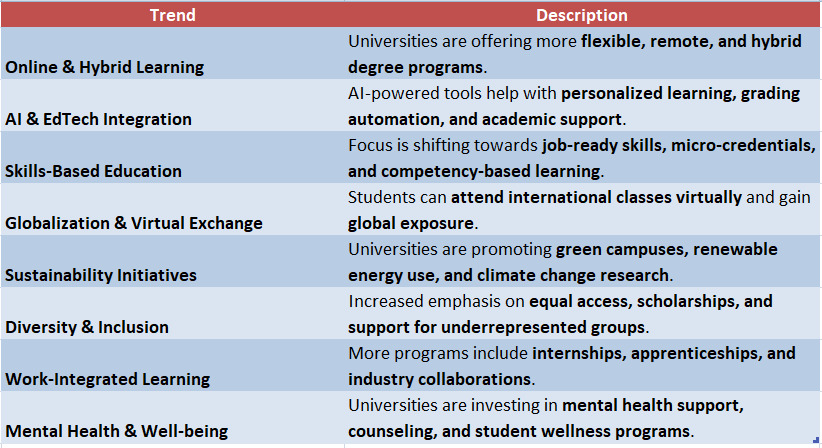
The future of university education is evolving rapidly, and understanding these changes is crucial for students, educators, and institutions alike. With technology advancing at lightning speed, the way we learn is transforming. One of the most significant trends in university education is the rise of online learning, which is reshaping how students engage with their studies.
Flexibility and Accessibility
Online learning offers students the flexibility to study from anywhere at any time. This means that whether you’re in a bustling city or a quiet town, you can access quality education. It’s especially beneficial for those balancing work, family, or other commitments.
Diverse Course Offerings
Digital platforms provide a wide range of courses, including specialized fields like Science and Early Childhood education. Students can explore subjects that interest them without being limited by their university’s offerings. This diversity encourages lifelong learning and personal growth. In conclusion, the trends in university education, particularly the rise of online learning, are making education more accessible and tailored to individual needs. As we move forward, embracing these changes will be key to unlocking new opportunities for students everywhere.
Start your journey to a brighter future—Enroll now!
Are Microcredentials the Future of Higher Education?

As we look towards the future, understanding the trends in university education is crucial. One of the most exciting developments is the rise of microcredentials. These short, focused courses offer a way for students to gain specific skills quickly, making education more accessible and relevant to today’s job market.
Microcredentials are becoming popular for several reasons. They allow students to learn at their own pace and focus on what truly interests them. For example, someone passionate about science and early childhood education can take targeted courses that enhance their knowledge without committing to a full degree program.
Key Benefits of Microcredentials
- Flexibility: Students can learn anytime, anywhere.
- Specific Skills: Focus on what employers want.
- Cost-Effective: Often cheaper than traditional degrees.
In a world where technology and job requirements change rapidly, microcredentials may just be the key to staying relevant. They empower learners to adapt and grow, ensuring that education evolves alongside the needs of society.
The Impact of Artificial Intelligence on University Curricula
As we look ahead, understanding the trends in university education is crucial. One of the most exciting developments is the impact of artificial intelligence (AI) on university curricula. This technology is reshaping how students learn and what they learn, making education more relevant and engaging.
AI is not just a buzzword; it’s changing the landscape of education. Here are some key ways AI is influencing university courses:
- Personalized Learning: AI can analyze student performance and tailor lessons to fit individual needs. This means students can learn at their own pace, making education more effective.
- Enhanced Research Opportunities: With AI tools, students in fields like science and early childhood education can conduct more sophisticated research, leading to innovative discoveries.
- Skill Development: Universities are incorporating AI into their programs, ensuring students are equipped with the skills needed for future jobs. This is essential in a world where technology is constantly evolving.
In summary, the integration of AI into university curricula is a game-changer. It not only enhances learning experiences but also prepares students for a tech-driven future. As these trends in university education continue to evolve, staying informed is key.
Sustainability in Education: What Trends Are Emerging?
As we look to the future, understanding the trends in university education is crucial. These trends not only shape how students learn but also prepare them for a world that increasingly values sustainability. With climate change and social responsibility at the forefront, universities are adapting to meet these challenges head-on.
Eco-Friendly Campuses
Many universities are transforming their campuses into eco-friendly spaces. This includes using renewable energy sources, reducing waste, and promoting green transportation. Students are encouraged to participate in sustainability initiatives, making them active contributors to a healthier planet.
Curriculum Innovations
Courses are evolving to include sustainability topics. For example, programs in science and early childhood education now emphasize environmental stewardship. This prepares future educators to instill these values in young learners, ensuring that sustainability becomes a core part of education.
Community Engagement
Universities are also partnering with local communities to promote sustainability. Through service-learning projects, students gain hands-on experience while making a positive impact. This connection fosters a sense of responsibility and encourages lifelong commitment to sustainable practices.
How Globalization Is Influencing University Education Trends
In today’s rapidly changing world, understanding the trends in university education is crucial. As globalization continues to shape our societies, universities must adapt to meet the needs of a diverse student population. This evolution not only impacts what students learn but also how they learn it, making it an exciting time for education.
Embracing Diversity
Globalization brings together students from various backgrounds. This diversity enriches the learning environment, allowing students to share different perspectives. Universities are now focusing on inclusive curricula that reflect global issues, preparing students for a connected world.
Technology Integration
With the rise of online learning, universities are leveraging technology to enhance education. Students can access courses from anywhere, making education more flexible. This trend is particularly beneficial for fields like Science and Early Childhood, where practical experiences can be shared through virtual platforms.
Collaborative Learning
Globalization encourages partnerships between universities worldwide. Collaborative programs allow students to study abroad or participate in joint research projects. This not only broadens their horizons but also equips them with skills needed in a global job market.
In conclusion, as globalization continues to influence university education trends, students can expect a more diverse, flexible, and collaborative learning experience. This shift prepares them for a future where they can thrive in an interconnected world.
Start your journey to a brighter future—Enroll now!
The Role of Student-Centered Learning in Modern Universities
In today’s fast-paced world, understanding the trends in university education is crucial. As students prepare for their futures, universities must adapt to meet their needs. One significant trend shaping this future is the shift towards student-centered learning, which focuses on the individual needs and interests of each student.
Student-centered learning emphasizes active participation. Instead of just listening to lectures, students engage in discussions, group projects, and hands-on activities. This approach helps students connect what they learn to real-life situations, making education more relevant and exciting.
Key Benefits of Student-Centered Learning
- Personalized Experience: Students can explore their interests, especially in fields like science and early childhood education.
- Improved Engagement: When students take charge of their learning, they are more motivated and involved.
- Better Outcomes: Research shows that student-centered methods lead to higher retention and understanding of material.
As universities embrace these trends, they prepare students not just for jobs, but for lifelong learning and adaptability in an ever-changing world.
What Does the Future Hold for Traditional University Structures?
As we look ahead, the landscape of university education is changing rapidly. Understanding which trends are defining the future of university education is crucial for students, educators, and policymakers alike. With technology advancing and societal needs evolving, traditional university structures must adapt to stay relevant.
Embracing Technology
One major trend in university education is the integration of technology. Online courses and virtual classrooms are becoming more common. This shift allows students to learn from anywhere, making education more accessible than ever before.
Focus on Practical Skills
Another important trend is the emphasis on practical skills. Universities are now focusing on teaching students skills that are directly applicable in the workforce. Programs in fields like Science and Early Childhood are evolving to include hands-on experiences, ensuring graduates are job-ready.
Personalized Learning Paths
Lastly, personalized learning is gaining traction. Students can choose their own paths based on interests and career goals. This flexibility helps cater to diverse learning styles, making education more engaging and effective. As these trends continue, the future of university education looks bright and promising.
How DegreeOnline.Education Can Help You Navigate the Changing Landscape of University Education
As we look to the future, understanding the trends in university education is crucial. These trends shape how students learn and prepare for their careers. With the rise of technology and changing job markets, universities must adapt to stay relevant. This is where DegreeOnline.Education comes in, guiding you through these exciting changes.
Embracing Technology
- Online courses are becoming more popular, allowing students to learn from anywhere.
- Virtual reality and simulations are enhancing hands-on learning experiences.
Focus on Science and Early Childhood
- Programs are increasingly integrating science into early childhood education.
- This trend prepares future educators to foster curiosity and critical thinking in young learners.
Personalized Learning Experiences
- Universities are offering tailored programs to meet individual student needs.
- This approach helps students engage more deeply with their studies, making learning more effective.
By staying informed about these trends, DegreeOnline.Education empowers you to make smart choices about your education. Whether you’re interested in science or early childhood education, we provide the resources you need to thrive in this evolving landscape.
Start your journey to a brighter future—Enroll now!
FAQs
-
What are the biggest trends in university education today?
Some major trends include online learning, hybrid education, micro-credentials, personalized learning, and the rise of AI in education. -
How has technology changed university education?
Technology has introduced digital classrooms, virtual labs, AI-based tutoring, and adaptive learning platforms, making education more accessible and personalized. -
What is the impact of online and hybrid learning on universities?
Online and hybrid models provide flexibility, increase access to education, and allow students to balance studies with work and personal life. -
Are traditional four-year degrees still relevant?
While traditional degrees remain valuable, many students are opting for shorter, skill-based programs like boot camps and micro-credentials to enter the job market faster.
-
What are micro-credentials and how are they changing university education?
Micro-credentials are short, focused courses that allow students to gain specific skills and certifications in a shorter time than a traditional degree. -
What is competency-based education (CBE)?
CBE focuses on skill mastery rather than time spent in class, allowing students to progress at their own pace based on what they already know.




